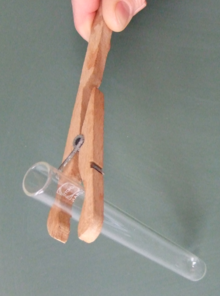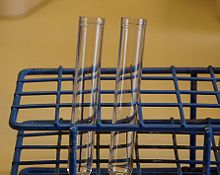Test tube
A test tube , also called eprouvette ( French : éprouver = to check) or test tube , is a small glass container that is open on one side .
Test tubes are used in laboratories for chemical reactions , investigations, for storing small amounts of liquid and much more. They are produced in a wide variety of sizes (approx. 2 to 20 cm in length, between 0.6 and 3 cm in diameter). A standard size in chemical laboratories is 16 cm long with a diameter of 16 mm. If necessary, they can be closed with plastic sheeting , aluminum caps, cork , rubber or plastic stoppers (also known colloquially as stoppers ).
There are also test tubes with standard ground joints that can be closed with ground glass or plastic stoppers. Some are printed with a volume scale in milliliters .
Glasses that are to be heated in a flame (for example above the Bunsen burner ) are usually thin-walled in order to avoid breakage due to thermal stresses . However, there are also thicker-walled ones made of refractory glass.
The price of a simple standard-sized (16 cm) test tube is about 10 cents or up, with the material used and the variation playing a key role. For example, one made of brown glass with a standard cut and olive costs between € 3 and well over € 10.
Test tubes are available in various shapes, for example with a round, conical or straight bottom, with a beaded or straight edge.
The test tube is often held in place with a test tube holder for handling. The usual design resembles a longer wooden clothespin with a metal spring; Other test tube holders are made of bent wire and consist of two flat spring steel tongues enclosed in a wooden handle or a metal clamp with a wooden handle.
Experienced chemists clamp a test tube with their middle finger on the palm of their hand, open the screw cap or ground joint stopper of a reagent bottle with their thumb and index finger and hold it with it (placing it down could contaminate it) and pour the liquid into the test tube. This method can also be used to fill in powdered, non-clumping reagents, and the amount can then be dosed by tapping with the index finger of the hand holding the bottle.
When heating test tubes, the heating is regularly interrupted and the contents are shaken through by briefly tapping the test tube in the middle section with ring finger, middle finger and index finger without the liquid spilling over or burning on the hot glass. The opening of the test tube is not directed towards the face in order to prevent scalding or chemical burns as a result of delayed boiling .
Test tubes are often also placed in a test tube box (also known as a test tube rack or test tube rack).
Individual evidence
- ^ Brockhaus ABC Chemie , VEB FA Brockhaus Verlag Leipzig 1965, pp. 1173–1174.
- ↑ Otto-Albrecht Neumüller (Ed.): Römpps Chemie-Lexikon. Volume 5: Pl-S. 8th revised and expanded edition. Franckh'sche Verlagshandlung, Stuttgart 1987, ISBN 3-440-04515-3 , p. 3503.
- ^ A b Walter Wittenberger: Chemische Laboratoriumstechnik , Springer-Verlag, Vienna, New York, 7th edition, 1973, p. 18, ISBN 3-211-81116-8 .



